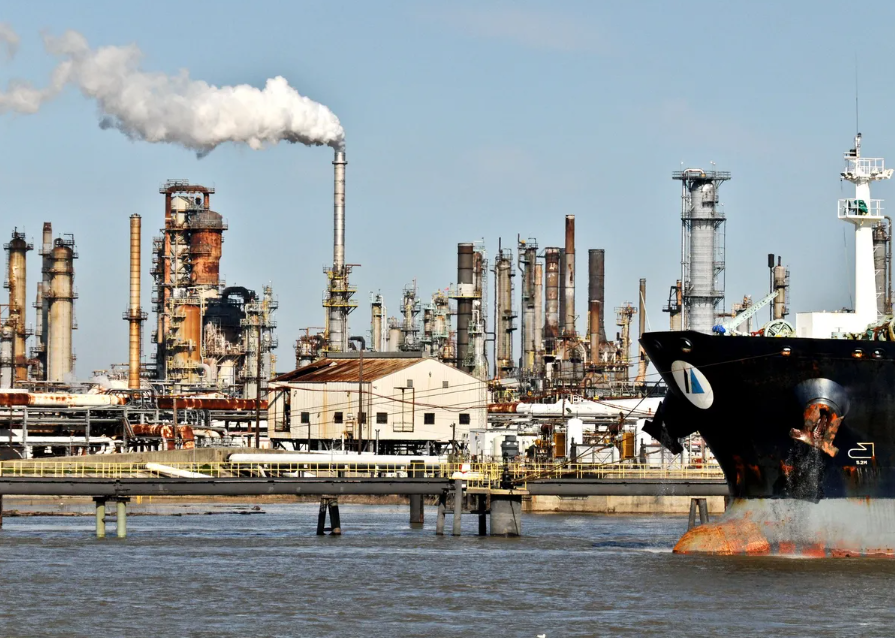But the U.S. Renewable Fuel Standard faces even larger problems

Chevron—whose oil refinery on the Mississippi River in New Orleans is pictured here—has developed a “biofuel” made from reprocessed plastic waste. DIGITALVUES/ALAMY
The U.S. Environmental Protection Agency runs the world’s largest biofuel program: the Renewable Fuel Standard (RFS). On its surface, the RFS requires providers of U.S. transportation fuel to blend in a certain quota of fuels from renewable sources.
But when is a renewable fuel not renewable?
On 23 February, ProPublica reported that the agency gave Chevron the thumbs-up to start producing an RFS-bound fuel made from reprocessed plastic waste—even though the fuel is a known cancer risk. Perhaps it is a harbinger: Even outside this particular fuel, the RFS is a program with a checkered past and an uncertain future.
From a 2023 vantage point, the entire program might seem like a relic of a bygone age. In the mid-2000s, when U.S. lawmakers established the program, few people foresaw that wind and solar would become so cheap, so quickly. Instead, the RFS’s architects put their faith in biofuels, such as fuel ethanol derived from corn or cellulose. At the time, U.S. fuel ethanol production was in bloom.
The RFS mandates that the blend powering U.S. vehicles—including cars, trains, and planes—include a certain yearly quota of renewable fuel. Petroleum refiners must supply a designated amount of RFS-friendly fuel, like fuel ethanol. If a refiner doesn’t fulfill its quota, it must purchase credits from a compliant counterpart.
The EPA holds final word over whether any fuel qualifies for credits—and if any fuel can be made at all. A would-be producer must submit information on a chemical, how it’s made, and any by-products from the process. The EPA crunches the data and determines if the chemical presents “an unreasonable risk.” If so, the EPA may mandate restrictions on its manufacture: Perhaps it can be made only with certain engineering controls, or perhaps workers have to take particular protections in handling it.
In early 2022, the EPA—supposedly due to a budget crunch—implemented a new, expedited process for approving new RFS-friendly fuels. Through this new pipeline, Chevron submitted a chemical created from reprocessed plastic waste.
The EPA promptly approved it, mandating only that the substance be limited to use as fuel and that workers had to wear gloves while handling it—even if, as ProPublica reported, 1 in 4 people exposed to the fuel for a lifetime were at risk of developing cancer, compared to the EPA’s benchmark of 1 in 1 million.
The EPA’s motivations aren’t clear. An EPA spokesperson told ProPublica and The Guardian that Chevron’s fuel wasn’t an exception—that, of the 34 fuels submitted through the new process, 16 purportedly contained waste, with an undisclosed amount specifically containing plastic waste. On the other hand, whistle-blowers have accused the EPA division responsible for stewarding the new process of corruption and workplace toxicity.
What is clear is that the RFS has a troubled history. Farmers, motivated by the program, have expanded the land they used to grow crops—namely corn. Those land-use changes had knock-on environmental consequences; one study suggested that RFS biofuel wasn’t any less carbon-intensive than gasoline, and another study found that the RFS caused a noticeable increase in runoff into U.S. waters.
Moreover, the RFS has repeatedly missed its yearly targets. A 2011 document claimed that the RFS put the United States “on a course charted to achieve a substantial increase in biofuels.” Instead, U.S. fuel ethanol growth drastically slowed in the 2010s.
Can the RFS be changed? In Chevron’s case, the EPA already has that power. “EPA has the authority to reopen that order and put more restrictions into place. But if EPA chooses not to reopen the order and address those risks, then [Chevron] can just move forward,” says Maria Doa, senior director of chemicals policy at the Environmental Defense Fund, and formerly a scientist at the EPA. Doa says that the EPA has revised its mandates in the past, typically when it learned new information.
The RFS could also start more strictly enforcing guidelines baked into it from the start, meant to prevent biofuel producers from overrunning sensitive, native habitats with cropland. “The way that’s implemented right now, it basically doesn’t work,” says Tyler Lark, environmental researcher at the University of Wisconsin–Madison. “It’s basically not implemented right now.”
Meanwhile, the EPA is already modernizing the RFS with an even more sweeping change: bringing electric vehicles into the RFS. In particular, the EPA’s 2023 targets include credits for biofuels, such as biogas, bound for generating the electricity that powers EVs.
But even if EVs do replace all of the world’s gas-guzzling cars in short order, more traditional fuels may still have their place in the sun, where they can power passenger aircraft, cargo vessels, and other transport modes that aren’t easily electrified. That would leave plenty of reason for the RFS’s original purpose to abide.
So there is reason for the RFS’s stewards to steer the program toward less risk. “[The RFS] is not a silver bullet. It’s not a great solution. Let’s be conscious and cognizant and upfront about, like, there are trade-offs to it,” says Lark.